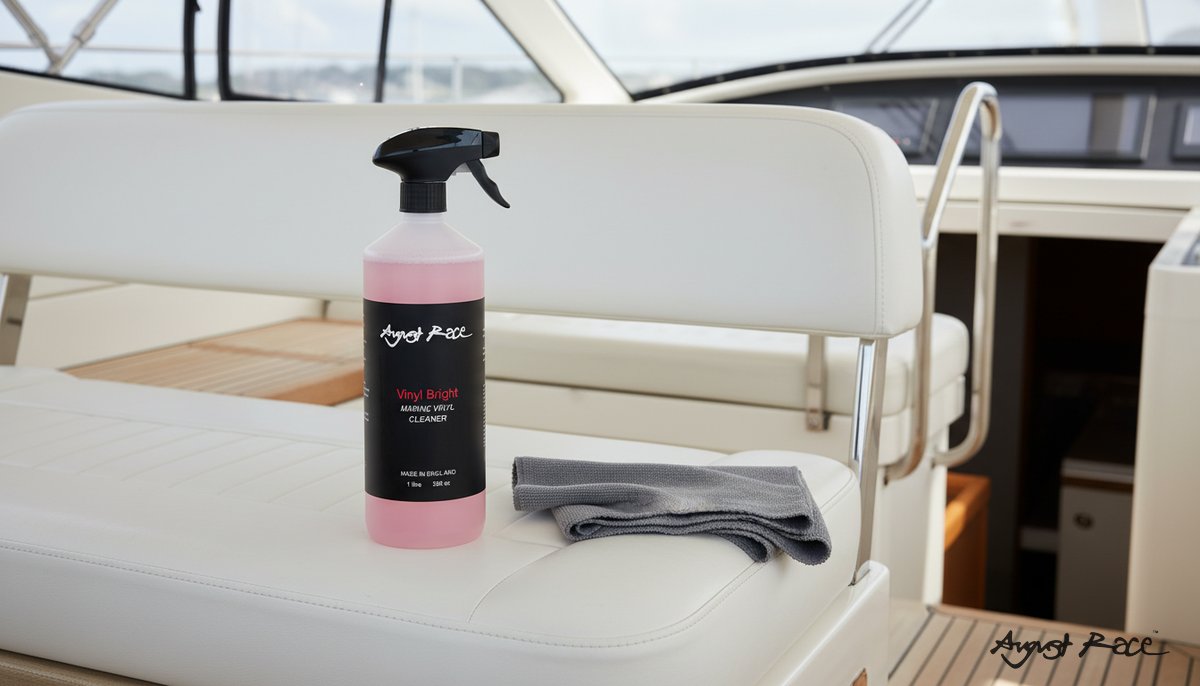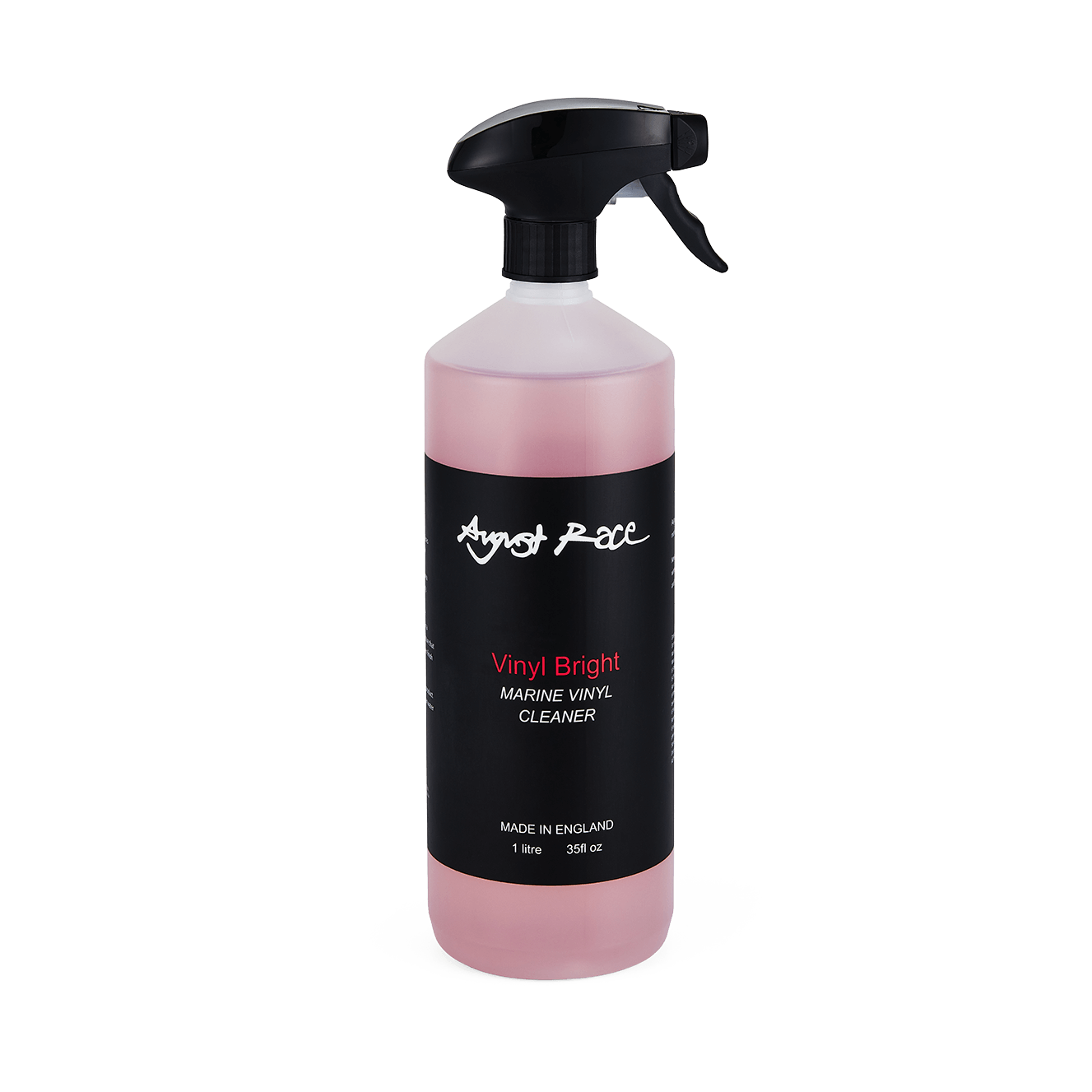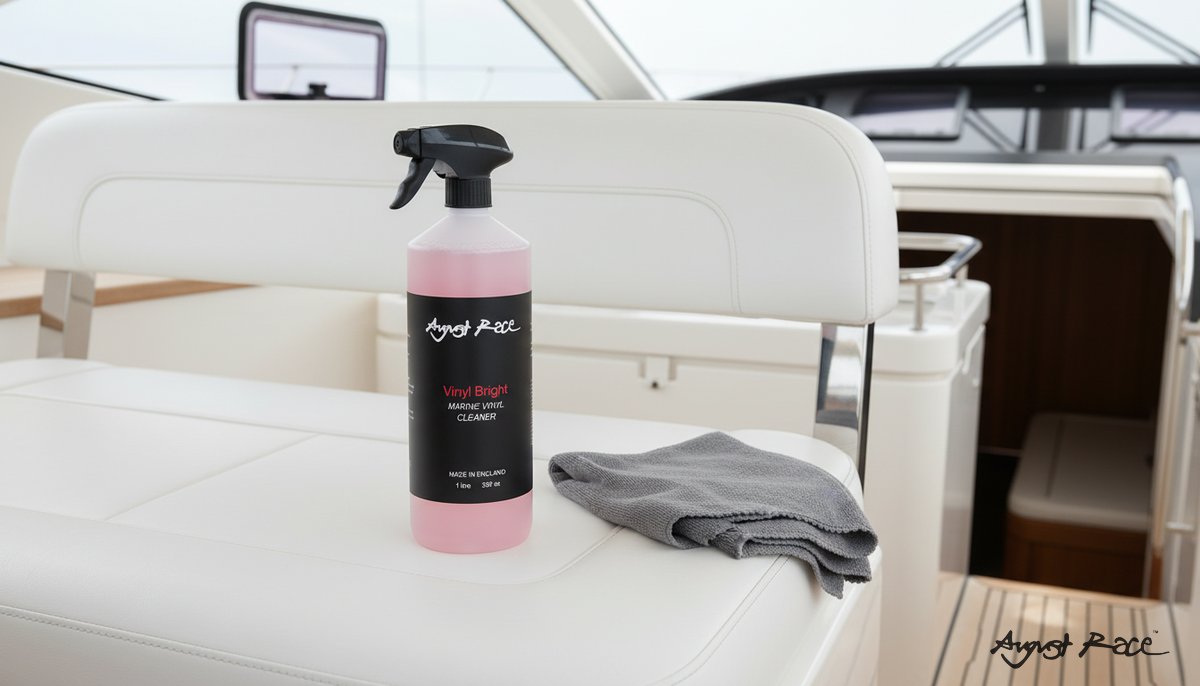August Race Vinyl Bright: The Safe Vinyl Cleaner Detailing Pros Trust
A morning on the dock: why I don't take chances with vinyl
I step onto the dock just after sunrise and zip open the cockpit cover. The seats tell the story before the owner does -- sun-bleached tops, a light film of sunscreen and salt, a few gray fingerprints where crew grab the coamings. Before I lift a bottle, I run my mental checklist: what vinyl grade am I looking at, how old is it, any prior repairs or re-dyes, and what finish the client expects today -- factory-matte, satin, or a soft sheen.
This is where chemistry matters. I’m judged by how the boat looks when I leave and how it holds up after a month of sun, spray, and traffic. A safe vinyl cleaner that’s marine-safe and non-abrasive isn’t just a convenience; it’s my reputation and the client’s upholstery protection wrapped into one choice. Aggressive cleaners can strip soils fast, but they can also burn the grain, lift color, or dry out the surface. You might win the day and lose the season.
That’s why my go-to on boats is the marine vinyl upholstery cleaner. It’s a gentle marine vinyl cleaner designed for on-water use and daily soils. The right product keeps me on the repair side of the line -- not the replace side.
Common vinyl problems I fix daily (and what causes them)
When you work boats all week, the patterns are obvious:
- Surface dirt and oils: sunscreen, sweat, diesel haze, and dock grime bond to textured grain.
- Mildew stains: moisture trapped under covers and wet towels left on the seats.
- Sun-induced chalking and fading: UV breaks down polymers, leading to a dull, powdery feel.
- Micro-abrasions: caused by stiff brushes or scouring pads -- tiny cuts that collect dirt and worsen stains.
Under the microscope, here’s what’s happening:
- UV polymer breakdown and plasticizer migration dry the surface, making it brittle and prone to cracking.
- Alkaline overexposure (from harsh household cleaners) swells and opens the grain, leaving tackiness.
- Mechanical abrasion from the wrong brush or pad shears the topcoat and embeds dirt deeper into the texture.
You can diagnose by touch. If your finger drags and picks up powder, UV has started to chalk the surface. If seams feel sharp and brittle, plasticizer loss is underway. Slight tack or smearing after cleaning often signals chemistry that’s too hot or residue left in the pores. The wrong tools and formulas don’t just leave the job unfinished -- they actively fight your plan to maintain vinyl integrity and prevent vinyl fading.
Why formulation matters: what makes a cleaner truly marine-safe and non-abrasive
“Marine-safe” isn’t a marketing flourish for me; it’s a requirement. On a boat, runoff goes straight to water and residues can sit under covers in heat. For vinyl, I’m looking for:
- Balanced pH suited for coated marine vinyl -- not highly caustic or acidic.
- No harsh solvents that can swell or extract plasticizers.
- Detergents and surfactants that lift oils and biofilm without attacking the topcoat.
- A non-abrasive cleaner that relies on chemistry and light mechanical action, not grit or cutting compounds.
Where compounds cut paint, a vinyl-safe formula should not “cut” the grain. You want soil release, not surface removal. That’s the distinction: cutting compounds and aggressive pads belong on gelcoat and paint correction, not on soft marine seating.
Compared side by side with heavy-duty household cleaners, the Vinyl Bright cleaner is formulated with marine use in mind and daily-detail power without the harsh edge. It’s designed to remove sunscreen, grime, and mildew film while respecting the finish -- so you can clean with confidence and keep upholstery protection plans intact.
Always patch test before full application. Choose a hidden area, apply a small amount, agitate lightly, and let it dwell for 30–60 seconds. Wipe and watch for three things -- color shift, surface tack, and dry-down feel. If the vinyl rebounds to a natural, even matte without stickiness and no dye transfer on your towel, you’re cleared for the main areas. If tack persists, extend rinse and lower dwell time.
Step-by-step: professional cleaning and protection workflow with August Race Vinyl Bright
Below is the exact workflow I use to get consistent results with a gentle marine vinyl cleaner while protecting the finish.
1) Preparation: tools and environment
- Shade and cool surfaces: Heat accelerates chemistry and can flash-dry product.
- Cleaner: Vinyl Bright cleaner. Use straight as directed; dilute only if your soils are very light.
- Brushes: Soft bristle detailing brush or flagged-tip upholstery brush. Avoid stiff nylon and anything labeled “scrub pad.”
- Towels: High-pile microfibre for lifting residue, plus a few edgeless towels for final wipe.
- Pads to avoid: No cutting pads, no medium foam, no microfiber cutting discs. These are for paint, not vinyl.
- Optional tools: Low-speed orbital polisher with a very soft finishing pad for lifting embedded grime without abrasion.
2) Application and agitation
- Pre-wipe: Knock loose dust and grit with a dry microfibre to prevent rubbing soil into the grain.
- Apply: Light, even application onto a small section (1–2 seat panels). Do not soak seams.
- Dwell: 30–60 seconds to let surfactants loosen oils and sunscreen. Keep it wet; don’t let it dry on.
- Agitate: Use a soft brush in tight circles, following the grain. Think “massage,” not “scrub.” You’re guiding chemistry, not forcing it.
Why no aggressive pad cutting motions on vinyl? Because that action heats and scours the topcoat, creating micro-sheer marks that trap grime later. We’re cleaning, not correcting.
3) Mechanical assistance (when needed)
- If hand work isn’t enough on textured areas, use a low-speed orbital at the lowest setting with an ultra-soft finishing pad.
- Work in light overlapping passes -- no pressure, just the tool’s weight.
- Check the pad often. If it loads with soil, swap it. A dirty pad becomes sandpaper.
4) Rinse and extraction
- Wipe: Use a damp microfibre to lift loosened soils and product. Flip often.
- Seams and stitching: Fold a towel edge or use a soft detailing swab to pull residue from seams. Leaving soap in stitching invites wicking and discoloration.
- Final rinse: Lightly mist fresh water onto the towel (not directly on the seat) and do a final pass to ensure no residue remains.
5) Protection and finish
- Once dry to the touch, apply your chosen vinyl-safe protector as recommended by the manufacturer. Keep it light; heavy coats attract dust.
- Buff: Use a clean edgeless microfibre. Long, straight passes deliver an even sheen without streaks.
- Inspection checklist:
-
Even color with no cloudy patches.
-
Natural feel -- no tack.
-
Seams clean and dry.
-
No residue transfer on a fresh white towel.
-
Run your hand across the panel. It should feel clean, consistent, and supple. Done right, this workflow delivers a deep clean and supports upholstery protection without compromising the surface.
Maintenance plan: keeping boat seats protected between professional details
The best way to protect boat seats from damage is to stay ahead of soils and sun. Here’s a simple schedule I give clients:
- After each outing: Quick wipe with a damp microfibre to remove salt and sunscreen.
- Weekly in-season: Light clean on high-touch zones (helm, transom entry, bow lounge) with a small dose of restore vinyl surfaces.
- Monthly: Full cockpit reset -- clean, dry, and apply a light, vinyl-safe protector.
- Pre- and post-season: Deep clean and inspection with photos for records.
Spot-cleaning technique:
- Mist the towel, not the seat, for small smudges. Blot -- don’t rub -- then follow with a dry towel.
- For mild mildew, treat early. A small, targeted application and soft agitation prevents a larger stain from setting in the grain.
Environmental management to prevent vinyl fading:
- Use breathable covers. Trapped moisture grows mildew; trapped heat accelerates polymer breakdown.
- Shade counts. If you can, store under UV-blocking shelter or add UV screens to biminis.
- Dry seating after washdowns and rain. Water left in seams feeds mildew.
Pro monitoring checklist:
- Pinch test: Squeeze an edge. If it creases and rebounds slowly, hydration is fading -- tighten your protection interval.
- Seam check: Look for early thread discoloration or fray.
- Colorfastness: Wipe a hidden spot with a damp white towel; if dye lifts, adjust dwell and protectors immediately.
Partnering with a detailing pro for scheduled service keeps the cycle tight and the finish consistent -- lower cost long-term than waiting for corrective work.
Real-world results: case studies from the pro bay
Case 1: Sun-faded bow lounge.
- Condition: Chalky top panels, sunscreen build-up, light grayness in grain.
- Process: Two passes of the marine vinyl upholstery cleaner with soft brush agitation, damp towel extraction, then a vinyl-safe protector.
- Time and materials: 45 minutes, three microfibres, one soft brush, minimal product.
- Outcome: Color recovery from dull to factory-matte, no grain loss, and tactile “clean” feel. Client avoided a re-dye and kept warranty intact.
Case 2: Mildew-stained cockpit bench.
- Condition: Shadowed spotting along seams from moisture under covers.
- Process: Targeted application, extended dwell (60 seconds), seam-swab extraction, second light pass. Dried thoroughly and left uncovered for airflow.
- Time and materials: 35 minutes, seam swabs, four towels.
- Outcome: 90% visual improvement, stain edges released without haloing. No tackiness or color lift; we maintained vinyl integrity and gained owner trust.
If a stain ghosts after two conservative passes, stop. Photograph, brief the client, and discuss expectations. Sometimes the honest professional call is a re-dye or replacement referral rather than risking damage with harsher chemistry.
How to specify August Race Vinyl Bright on your service menu (and pricing tips)
- Menu line item: “Vinyl Bright Clean & Protect -- marine-safe, non-abrasive.” List the steps briefly: inspect, clean, rinse/extract, protect.
- Pricing guidance: Quote by linear footage or seating zones. Estimate by labor time (light soils vs. restoration-level soils) and complexity (stitch count, texture). Offer an add-on for UV protectant application.
- Client handout: One-page care guide with your maintenance schedule, spot-clean instructions using the Vinyl Bright cleaner, and recommended follow-up intervals.
- Trial the system on one cockpit. Capture before/after photos and a 10-second tactile “squeak test” video for marketing. Real results sell better than copy.
Quick reference and pro troubleshooting
Reference notes:
- Dilution: Use as directed; dilute only for very light maintenance cleans.
- Pads to avoid: Cutting pads, microfiber cutting discs, melamine sponges. These abrade topcoats.
- Over-application: If product dries on the surface, re-wet, gently agitate, and wipe clean. Follow with a damp towel to reset the finish.
Three common issues and quick fixes:
- Color lifting: Stop immediately. Rinse with a damp towel, reduce dwell time, and re-test a hidden patch. Consider that a prior re-dye may be bleeding.
- Gummy residue: You’re either overworking the area or leaving product behind. Shorten dwell, lighten agitation, and increase your rinse/extract passes.
- Stitching discoloration: Extract residue from seams with a folded towel edge or soft swab. Avoid soaking, and dry with gentle airflow.
Compatibility and testing:
- Not all “vinyl” is equal. Some seats have coatings or re-dyes that behave differently. Patch test every new boat.
- When in doubt, consult the seat manufacturer or your product supplier for guidance specific to the substrate.
Careful technique preserves finish and client trust. Combine conservative tools with a safe vinyl cleaner like the Vinyl Bright cleaner, and you’ll protect results today and seats for seasons to come. Find it at the August Race shop.
FAQs
How can I protect boat seats from damage using a gentle marine vinyl cleaner?
Mist the cleaner lightly, let it dwell briefly, agitate with a soft brush, and extract with clean microfibres so chemistry -- not abrasion -- does the work. Finish with a vinyl-safe protectant and follow a weekly wipe-down routine to prevent soils from embedding and to protect boat seats from damage.
What is the best way to maintain vinyl integrity and prevent vinyl fading over time?
Clean in the shade with a non-abrasive cleaner, then apply a UV protectant on a regular schedule. Store under breathable covers, dry seating after use, and avoid harsh household cleaners that over-dry and accelerate fading.
How do I perform a patch test to ensure a safe vinyl cleaner won't harm upholstery?
Choose a hidden area, apply a small amount, and allow 30–60 seconds of dwell before light agitation and wipe-off. Check for dye transfer on a white towel, any tacky feel, or color shift; if none appear after a few minutes, proceed to visible areas.
Can I use an orbital polisher on vinyl seating, and what pads should I avoid?
You can use a low-speed orbital with an ultra-soft finishing pad to lift embedded grime, applying no pressure and working in short passes. Avoid cutting pads, microfiber cutting discs, and melamine sponges, as they can abrade the vinyl topcoat.
About the Author
Sarah Rodriguez
The Detailing Professional
Owner of a high-end marine detailing business catering to luxury yachts and charter fleets. Sarah's reputation and business depend on delivering flawless results efficiently.
Expertise:
Get Expert Tips
Subscribe for marine care insights and product updates from industry professionals.
No spam. Unsubscribe anytime.
You May Also Like

Fast Inflatable Boat Cleaner: August Race Liquid RIB
Keep your tender pristine in minutes with an apply-and-wipe, no dwell time cleaner RIB owners trust. Remove salt, grime, and carbon marks from PVC tubes fast.

Marine Vinyl Cleaning with August Race Vinyl Bright
Remove pink stains and mildew safely from boat vinyl using non-abrasive chemistry. Field-tested process with August Race Vinyl Bright.

Vinyl Bright by August Race — Non‑Abrasive Power for Marine Vinyl Mildew
Non-abrasive marine vinyl cleaner that removes mildew and mold fast while preserving color, texture, and feel of boat upholstery.
